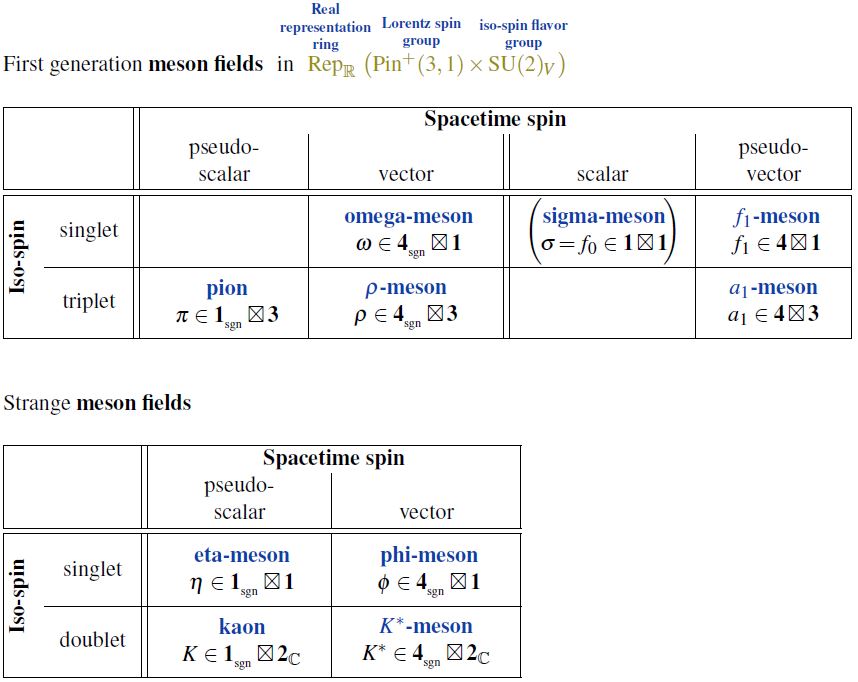nLab σ-meson
Context
Fields and quanta
fields and particles in particle physics
and in the standard model of particle physics:
matter field fermions (spinors, Dirac fields)
| flavors of fundamental fermions in the standard model of particle physics: | |||
|---|---|---|---|
| generation of fermions | 1st generation | 2nd generation | 3d generation |
| quarks () | |||
| up-type | up quark () | charm quark () | top quark () |
| down-type | down quark () | strange quark () | bottom quark () |
| leptons | |||
| charged | electron | muon | tauon |
| neutral | electron neutrino | muon neutrino | tau neutrino |
| bound states: | |||
| mesons | light mesons: pion () ρ-meson () ω-meson () f1-meson a1-meson | strange-mesons: ϕ-meson (), kaon, K*-meson (, ) eta-meson () charmed heavy mesons: D-meson (, , ) J/ψ-meson () | bottom heavy mesons: B-meson () ϒ-meson () |
| baryons | nucleons: proton neutron |
(also: antiparticles)
hadrons (bound states of the above quarks)
minimally extended supersymmetric standard model
bosinos:
dark matter candidates
Exotica
Contents
Idea
The sigma-meson, now also called the -resonance, is the lightest Lorentz-scalar and isospin-scalar meson.

Together with the omega-meson the sigma is responsible for most of the long-range interaction between baryons, exhibiting the residual strong nuclear force between them, at least as modeled by the Walecka model and quantum hadrodynamics.
Other models of quantum hadrodynamics do not contain the sigma at all. See Pelaez 16 for review of the controversial and inconclusive understanding of the sigma-meson.
Related concepts
References
General
Original articles:
-
Murray Gell-Mann, M. Lévy, The axial vector current in beta decay, Il Nuovo Cimento (1955-1965) volume 16, pages 705–726 (1960) (doi:10.1007/BF02859738)
-
Julian Schwinger, A Theory of the Fundamental Interactions, Annals Phys. 2 (1957) 407-434 (spire:12286)
Review:
- J. R. Pelaez, From controversy to precision on the sigma meson: a review on the status of the non-ordinary resonance, Physics Reports 658 (2016) 1 (arXiv:1510.00653)
See also:
-
Eef van Beveren, Frieder Kleefeld, George Rupp, Michael D. Scadron, Remarks on the scalar meson as the dynamically generated chiral partner of the pion, Mod. Phys. Lett. A17:1673, 2002 (arXiv:hep-ph/0204139)
-
M. Albaladejo, J.A. Oller, On the size of the sigma meson and its nature, Phys. Rev. D 86, 034003 – Published 3 August 2012 (arXiv:1205.6606, doi:10.1103/PhysRevD.86.034003)
-
S. S. Afonin, T. D. Solomko, The sigma meson from QCD sum rules for large- Regge spectra, Eur. Phys. J. C 76, 678 (2016) (arXiv:1608.08131)
-
S. S. Afonin, T. D. Solomko, The linear radial spectrum of scalar mesons within the QCD sum rules in the planar limit, Eur. Phys. J. C 76, 678 (2016) (arXiv:1608.08131)
-
Physics.SE discussion, What the heck is the sigma (f0) 600?
-
Christian S. Fischer, Paul C. Wallbott, Richard Williams, Nico Santowsky, Gernot Eichmann, The -meson: four-quark vs. two-quark components and decay width in a Bethe-Salpeter approach (arXiv:2007.06495)
Inclusion of the sigma-meson into the Skyrme model for baryons:
- Thomas D. Cohen, Explicit meson, topology, and the large- limit of the Skyrmion, Phys. Rev. D 37 (1988) (doi:10.1103/PhysRevD.37.3344)
In holographic QCD
Discussion in holographic QCD:
On sigma-mesons and omega-mesons mediating baryon interaction, discussed in holographic QCD via D3-D7 brane intersections:
- Anatoly Dymarsky, Dmitry Melnikov, Jacob Sonnenschein, Attractive Holographic Baryons, JHEP 06 (2011) 145 (arXiv:1012.1616)
and discussed in the Witten-Sakai-Sugimoto model on D4-D8 brane intersections:
- Vadim Kaplunovsky, Jacob Sonnenschein, Searching for an Attractive Force in Holographic Nuclear Physics, JHEP 05 (2011) 058 (arXiv:1003.2621)
Last revised on March 4, 2023 at 21:00:16. See the history of this page for a list of all contributions to it.